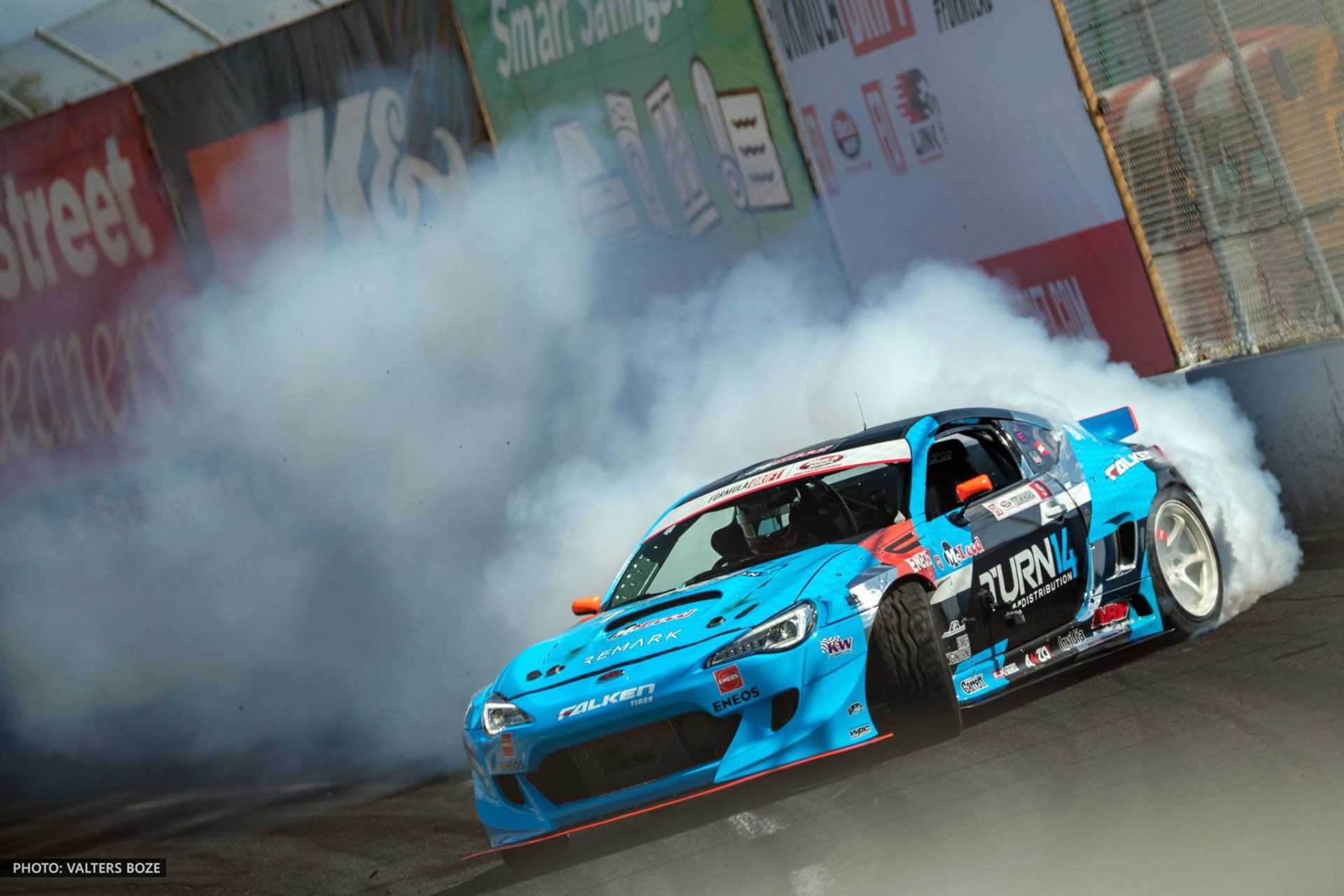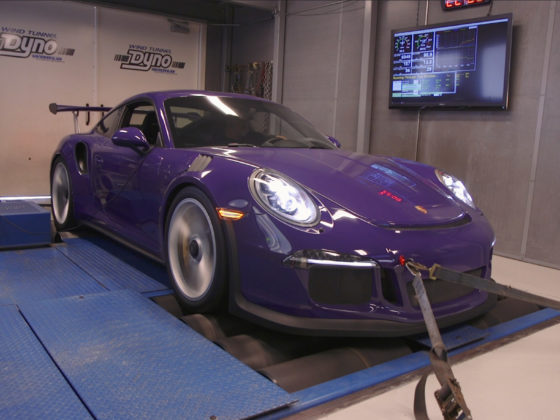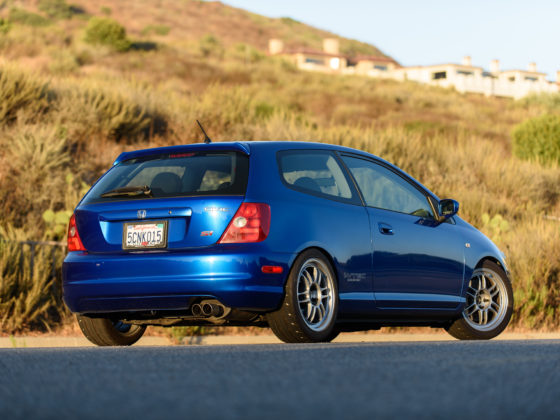
Action shots by Valters Boze
When we first got started with our technical involvement in Formula Drift’s Pro Series 10 years ago, the state of the art in drift car braking was something pretty basic. The front brakes were usually a medium-sized 4 piston caliper with a solid disc two piece rotor like something from a Sprint car that was designed for light weight and medium clamping force. A dual master cylinder with a balance bar was used. For rear brakes, a solid rear 2-piece rotor was squeezed by two small 4 piston calipers.
At the time, 450 hp was considered adequate for drifting and tire development was a few generations behind what it is now. About this time Pro drifting was starting to undergo a technical revolution and advances in tire and suspension technology would soon take the sport to a new level. If you doubt it, go on YouTube and look at FD competition circa 2008 vs now, you will be amazed at how much the sport has evolved. Our current Pro-Am Drift League drivers are better than the top pros back in the day!

Here is a typical state of the art front brake setup from 2008. A medium-sized 4 piston caliper with a lightweight two-piece solid front rotor. The rotor was a sprint car part which was also used in some drag racing applications. The cars were much slower in those days and the brakes were only used to position the car. Only a few drivers like Tanner Foust, Rhys Millen, and Samuel Hubinette did much left-foot braking. The cars were much slower and the needs for really powerful brakes didn’t exist. Light weight and braking power were important but fade resistance was not an issue.

Rear brakes consisted of two small 4-piston calipers, one activated by the brake pedal and the other by a hand operated lever. a lot of people used two piston or OEM single piston calipers at this time as well. Again a solid two-piece rotor is used with the emphasis on lightweight over thermal resistance. The rear brakes were mostly only used to help initiate the drift. In those days the brake bias was set up much like in road racing with only a slightly greater than typical front bias. Left foot braking was more used as a weight transfer trick to help initiate drift and only a few drivers consistently did it.

Fast forward to what was used in around 2013. In 2012 some guy named Daigo Saito came from Japan and turned the drifting world upside down. Daigo is the guy responsible for the era of the 1000 plus hp cars. With his overwhelming horsepower, sticky Achilles tires and unconventional (for the USA) driving style, Daigo dominated for that season and left everyone thunderstruck. Daigo single handily launched a technological war where the other tire manufactures greatly improved their performance while the car builders made huge gains in power and suspension. The drivers also upped their game while Formula Drift changed their style of judging to make Daigo’s, lunge at you, knock over all the cones style less of an advantage to favor more of a door to door follow with high angle over speed being favored.
This greatly changed how drivers drove and created a different emphasis on brakes. Since cars now had a lot more power with gripper tires a lot more was demanded of the brakes. To drive with more angle and generate more smoke while keeping powerful engines in their powerband, more drivers started to adopt heavy left foot braking with less rear bias on the foot pedal, often using the brakes to adjust the angle while keeping the engine on the boil. These changes to the sport also meant that brake systems had to change.
Here is a front brake system from that era. The solid rotor has given way to a vented rotor albeit a thin one with minimal venting and the caliper has evolved into a larger six-piston unit. This is a big step up from the circa 2009 brake system.




12 comments
What is the purpose of the cross drilled rotor with integrated slots from the drilled hole? Does it prevent cracking from thermal expansion?
I looked all over Wilwood’s website but couldn’t find those particular rotors.
Its mostly to vent the pad outgassing. It actually makes the rotor more prone to cracking and isn’t done much anymore.
Those are thermal expansion slots, which certainly would have been to extend the time before cracking started. When iron rings heat up to competition temperatures, the expansion must be planned for. If not, then iron will crack sooner (beyond the normal “crazing”). There are better ways to deal with this, yet the sprint car/dirt track market typically operate on tight budgets,, so this would be one way to get there.
On the one hand it seems funny that Stoptech keeps coming up… but they really are at kind of a sweet spot. I know from pricing stuff up what a quantum leap up it is to go to the next tier of brakes, and I’m not sure, say, an Alcon TA6 (same pad shape too, I think) is more than incremental gains for the 4x (or so) price jump. I like that some of the newer calipers they’re doing are using more common racing pad shapes than the Brembo shapes the 40 calipers use.
I really like StopTech because they have the tremendous range of piston sizes which enables them to match OEM proportioning. People don’t realize how critical this is and how it affects a car’s electronics nowadays and if the car is an older car, how it affects pedal feel and balance. That’s not the case in this car because it is a race car with a pedal box but for cars with a single master cylinder, it’s amazingly good.
For their street kits, Stoptech also has rigorous validation testing. to assure the vehicle dynamics are safe. When developing frictions and caliper systems, they have OEM level brake dynos and do extensive validation that way as well. They also have a PHD tribologist and develop their own frictions in-house.
Sure Brembo and AP have some more advanced calipers but those are not the ones people typically use for street and grassroots applications. Those are no better than StopTech. StopTech’s engineering office is right down the street from us and they are very generous with help and technical support.
Brembo or AP’s engineering department would probably roll their eyes at the thought of working with a drift Team or not even have any knowledge that drifting has advanced to a high-level motorsport.
Yeah; I have to respect the niche that Stoptech has carved out for themselves. It was a little funny because until I looked it up I didn’t realize the STR60 was using as big of a pad as it is; I like that and a lot of their recent design decisions, and that’s leaving aside the validation they do.
I look at it sort of like… yeah, you end up using Stoptech in a lot of builds. But I know walking pits and looking at prototypes and GT cars and stuff in the 90s to recently (there’s more good options now but you know what I mean) basically everything would have Penske shocks… well, sometimes there is just a “best” solution given constraints.
The pad surface area doesn’t change braking performance, just pad life.
It looks like that kit was a little over engineered for this setup – you could have gone lighter and replaced twice per season? It just depends how much different rotational weight/inertia makes to chassis and tyre dynamics. And team budget of course!
We didn’t just throw some stuff on the car, I worked with StopTech’s engineering department to come up with a system that would solve our problems and improve our brake performance. Pad area doesn’t change the amount of brake torque produced but it can greatly affect the fade characteristics of the brake besides just affecting wear! The system is not overbuilt, it is sized correctly to take the thermal loading that the car produces. With our previous system, we had to run a very high mu aggressive pad with a narrow effective temperature range. Brake temperatures were sky high, the rotors would glow red hot and wear was extreme. Consistency was also an issue due to the pads narrow temperature operating range. Overall performance was adequate. Our new system is only 1.5 lbs per corner heavier in the front and 1 lb per corner in the rear. We are running a 335mm low mass front rotor, not the internally thicker and heavier high thermal capacity rotor. To reduce the capacity would run the thinner rotor, you would only be saving weight with the vane thickness not by reducing material in the friction surface, not worth it in my book.
Great answer Mike – I love your articles. Keep it up!
@Mike Kojima – how important is lightweight brakes (unsprung weight) and small discs (low inertia) for drifting suspension and chassis setup?
Well, you have to have enough brake to do the job, and too much is just weight in a bad place. Having enough brake is the most important thing.
Great answer Mike – I love your articles. Keep it up!